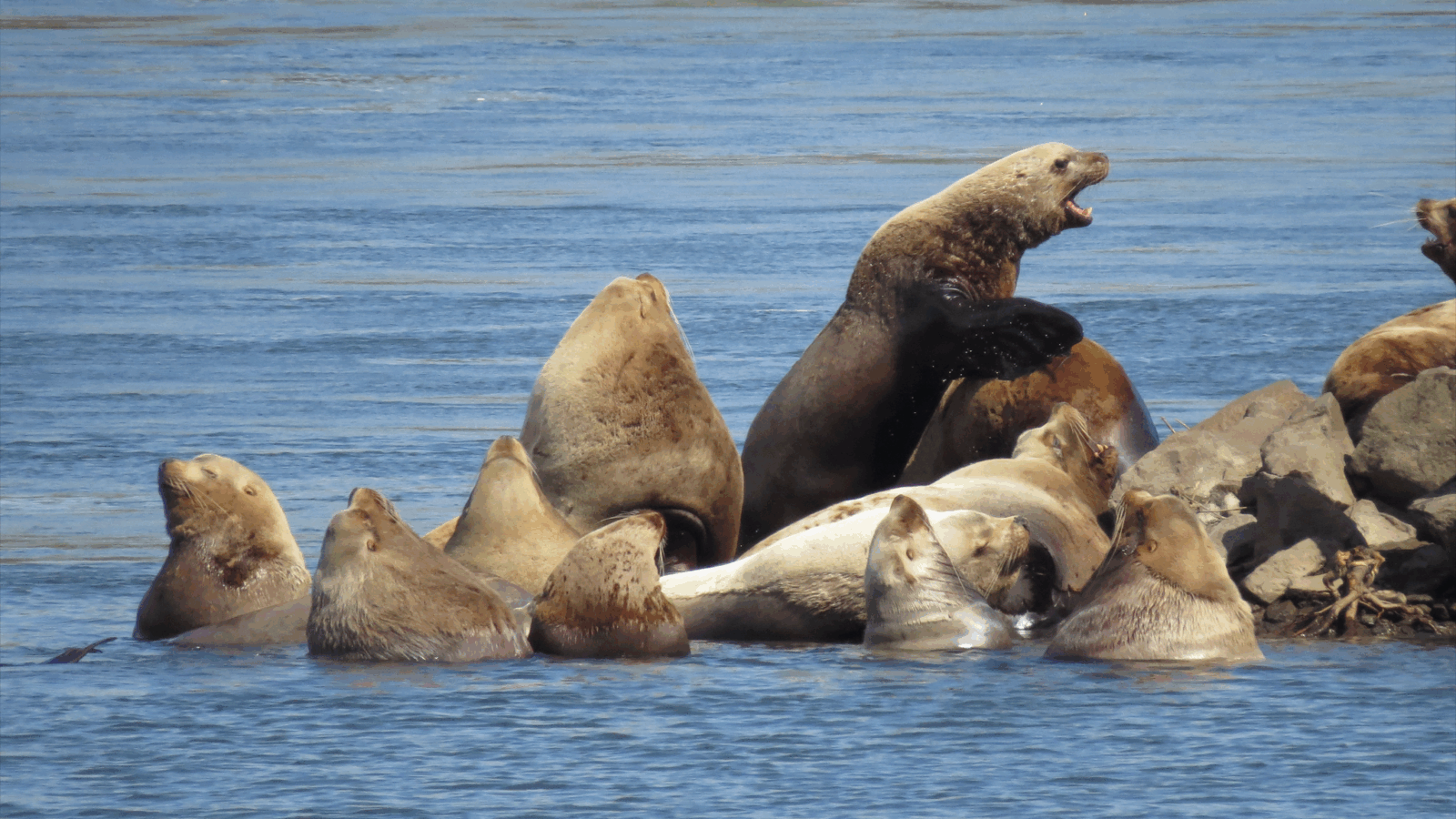Steller and California sea lions are known to take a big chunk of early migrating adult salmon and steelhead in the Columbia River, but a recent study has also found that Steller sea lions are eating more than 2 million young Chinook salmon along Washington’s northwest coastline.
During the study period, between December 2020 and August 2021, Steller sea lions consumed 284 metric tons of age-0 Chinook salmon (salmon that have spent less than one year in the ocean), the study found. That equates to 2,064,418 individual ocean age-0 Chinook and that high number of juveniles further equates to 14,771 adult (ocean age 2–4 years) Chinook salmon, the study’s authors estimate.
Despite reductions in commercial, recreational and tribal fishing, the number of Chinook salmon along the coast has declined “precipitously,” the study says. Mortality of ocean-age-0 salmon has been identified as a driver of this decline for both hatchery and wild Chinook along Washington’s coastline used by a diverse mix of Chinook salmon in their early marine life stage, the study says.
Natural mortality at this life stage is due to a number of factors, such as ocean temperatures, salinity, weather conditions, prey availability and predation and that mortality varies by location. Predation, hatchery release timing and human caused impacts like habitat degradation may be the strongest predictors of this decline, the study says.
“Further, the effects of climate change on early marine phase salmon through a combination of bottom-up and top-down trophic processes, including marine mammal predation, may limit the population growth of the species,” the study says. “Therefore, determining causal mechanisms of early mortality is critical for conservation and recovery efforts, and sustainable harvest management.”
While there has been a declining population of Chinook salmon along the Washington coast, steller sea lion abundance increased at a rate of nearly 8 percent per year from 2010 to 2017. Steller sea lions in Washington are part of the Eastern distinct population segment, which was delisted in 2013 from the federal Endangered Species Act. The delisting, according to the study, followed a population growth of 4.2 percent per year from 1979 to 2010.
The study, “Steller sea lion (Eumetopias jubatus) consumption of ocean age-0 Chinook salmon (Oncorhynchus tshawytscha) along the northwest coast of Washington State,” was published Nov. 12 in Plos One (Steller sea lion (Eumetopias jubatus) consumption of ocean age-0 Chinook salmon (Oncorhynchus tshawytscha) along the northwest coast of Washington State | PLOS One).
Study authors are Zoë K. Lewis, Biology Department, Western Washington University, Bellingham; Benjamin W. Nelson, Independent Consultant, Seattle; Adrianne M. Akmajian, Makah Fisheries Management, Makah Tribe, Neah Bay; Elizabeth M. Allyn, Makah Fisheries Management, Makah Tribe, Neah Bay; Sarah Brown, Washington Department of Fish and Wildlife, Olympia; Dietmar Schwarz, Biology Department, Western Washington University, Bellingham; and Alejandro Acevedo-Gutiérrez, Biology Department, Western Washington University, Bellingham.
The study’s objectives were three-fold: to measure what part of the sea lion diet was made up of Chinook (Dec. 2020 to Aug. 2021); to estimate the total biomass of prey consumed by steller sea lions; and to model the contribution of ocean age-0 Chinook to Steller sea lion diet using DNA metabarcoding.
Scientists took scat samples from Tatoosh Island at the mouth of the Strait of Juan de Fuca to Sea Lion Rock, 45 kilometers south. A DNA metabarcoding analysis was performed to estimate the proportion of DNA that could be attributed to Chinook salmon in the scat samples.
Some 274 steller sea lion scat samples were collected during the study (92 in the winter — December-February, 90 in the spring — March-May, and 85 in the summer June-August), the study results say. Chinook salmon were most prevalent in scats during spring and winter, and was highest relative to other salmon species in the spring. Summer detection of Chinook DNA was much lower. Some 51 percent of Pacific salmon remains were from age-0 individuals. That was highest in the winter.
Daily consumption was highest in December and it was the least in May. Adult males had the highest estimated daily consumption of age-0 Chinook per day and juvenile females had the lowest per day in all months; the total daily consumption of age-0 Chinook was similar for juvenile males and adult females, the study concludes.
The authors say that prior studies estimated lower consumption by all marine mammal species (includes all pinnipeds and killer whales), with just over 0.7 million Chinook salmon of all age classes along the entire outer Washington coast in 2015. That same study estimated that across the entire north Pacific, steller sea lions only consumed about 0.7 million Chinook (all ages) in 2015.
However, “across all alternative models, the median estimate for Chinook salmon consumption ranged from 1.5 to 3 million fish, reinforcing the conclusion that the contribution of age-0 Chinook to the Steller sea lion diet is greater than earlier estimates suggested.”
“Our study marks the first biomass modeling framework incorporating Steller sea lion DNA metabarcoding data to match previous work produced for other pinniped species,” the authors said. “Our consumption estimates of Chinook salmon by Steller sea lions were higher than estimates reported in previous studies of the region, which may be a factor of increased sea lion abundance, better data resolution, an increase in predation rates or some combination of those factors.”

